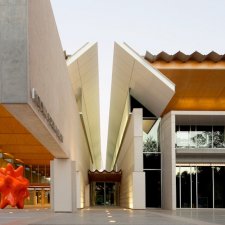- About us
- Support the Gallery
- Venue hire
- Publications
- Research library
- Organisation chart
- Employment
- Contact us
- Make a booking
- Onsite programs
- Online programs
- School visit information
- Learning resources
- Little Darlings
- Professional learning
Lloyd Rees AC CMG (1895-1988) was one of Australia's most celebrated landscape painters. The Brisbane-born artist developed his technique with pen and ink drawings of the city before moving to Sydney in 1917 to work in a commercial art studio. In the early 1930s he concentrated solely on drawing, particularly the rocky landscapes around Sydney, but by the late 1930s he began painting in an increasingly romantic manner. He remained actively painting and drawing until his death in Hobart at the age of 93. Rees taught art history at the University of Sydney for a number of years, and was a favourite with students. Rod Shaw knew and admired Rees and has depicted him here in heroic guise. The work refers to Rees's trip to Central Australia in the mid-1970s, which resulted in his masterly series of paintings of Uluru and Kata Tjuta (The Olgas).
Roderick Shaw studied art at East Sydney Technical College, and worked during the war at the Commonwealth Aircraft factory, painting camouflage alongside William Dobell and Joshua Smith. After the war he worked as a designer and illustrator, and was also a printer of quality books, producing volumes of poems by A.D. Hope and David Campbell, among others. Shaw and Dick Edwards together established The Barn on the Hill press in 1939. They were later instrumental in ending the censorship of four letter words in Australia by publishing the banned report of the trial of Penguin books over Lady Chatterley's Lover. Shaw designed the mural for the Waterside Workers' Federation Office, and has become best known for his worker paintings of the social realist school, such as Cable Layers, owned by the Art Gallery of NSW. For many years he taught at workshops and summer schools, and he was a foundation member of Artists for Democracy and of Artists Against Nuclear War.
Collection: National Portrait Gallery
Purchased 2001
© Estate of Roderick Shaw



On one level The Companion talks about the most famous and frontline Australians, but on another it tells us about ourselves.



Visit us, learn with us, support us or work with us! Here’s a range of information about planning your visit, our history and more!



We depend on your support to keep creating our programs, exhibitions, publications and building the amazing portrait collection!